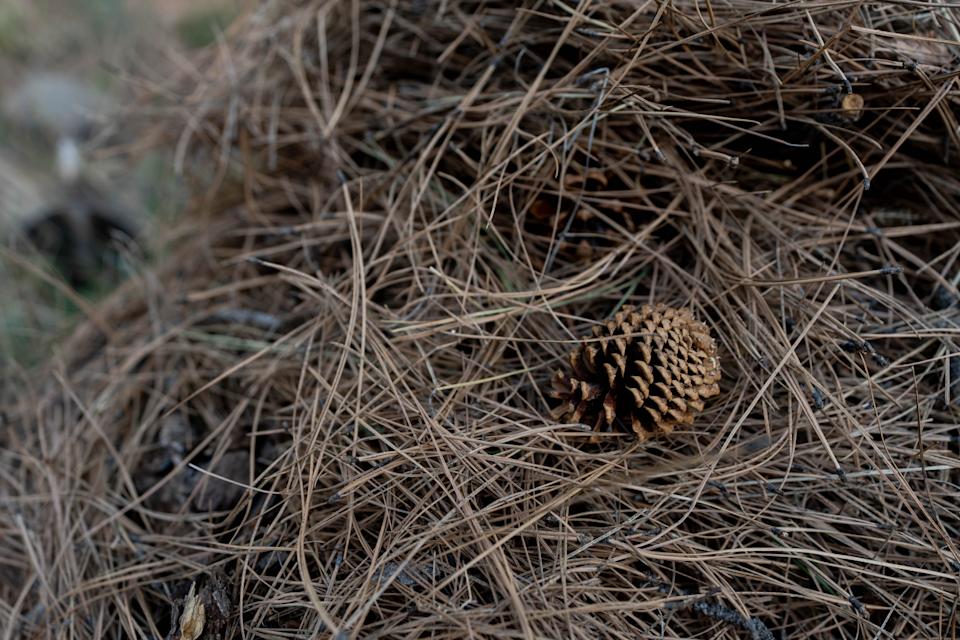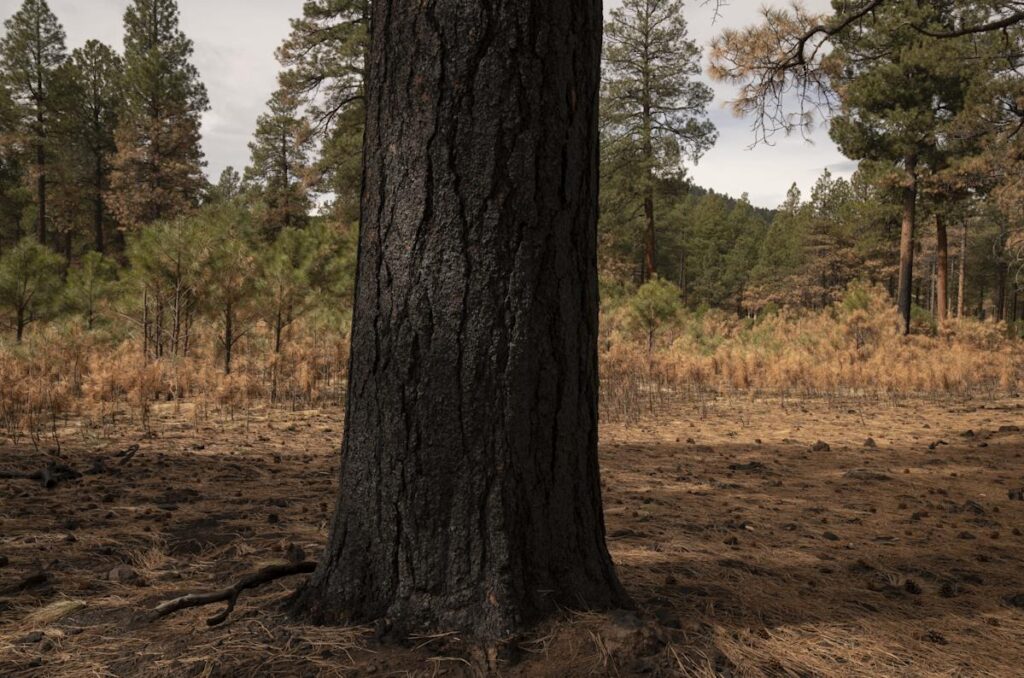Arizona wildfire season
Training wildland firefighters| Grassland threat| Urban wildfire risk
High-risk areas | Rebuilding smarter
Wildfire forecast
Western forests are still burning too infrequently for their own good, a finding that may seem paradoxical to Arizonans anticipating a dangerous fire year after a drought-plagued winter.
New research indicates that even the region’s big and destructive fire years, such as 2020, only eclipse 19th century norms for fire intensity — not for the number and reach of milder fires that regenerate the woods. Restoring an equilibrium that would allow fires to burn more widely and safely could require a massive investment in thinning and burning at a time when federal spending is itself under fire.
Following a pattern established when the U.S. Forest Service started widespread fire suppression more than a century ago, woodlands continue to accumulate fuel. It means that if fires get out of control in Arizona’s ponderosa pines or other corners of the Southwest, they’ll likely burn more intensely than if more natural conditions prevailed.
“These big, catastrophic fires are monsters of our own making,” said Donald Falk, a wildfire researcher and professor at the University of Arizona’s School of Natural Resources and the Environment.
Americans primed the woods for disaster by snuffing out low-intensity fires that restore balance, and by emitting the carbon that drives climate change. While prescribed fires emit carbon of their own, they may prevent untold emissions in the form of megafires that torch every stick.
Falk’s advice, beyond reducing emissions, is for forest managers to increase the combination of mechanical thinning and prescribed burning by at least tenfold. That’s also the finding in a study he and colleagues published in the journal Nature Communications in February. They analyzed tree rings from around North America to determine that, despite famously destructive fires in the age of climate change, most forests are burning less often than before 1880.
Fewer fires, more destruction
It’s not that fires don’t ignite as often as before, he said. It’s just that we don’t let them get far. The evidence is in fire scars on tree rings that survived low-intensity burns to keep growing across some 2,000 sites that the researchers analyzed spanning Alaska to southern Mexico. They compared the number of sites that saw fire before 1880 to those where fires burned since 1984.
During 2020, the Southwest’s largest contemporary fire year — when the Bighorn Fire raged on Mount Lemmon above Tucson — Falk said only 22% of the Southwestern tree ring study sites burned. In the pre-1880 era, he said, 30% to 50% would have burned in any given year, and more than 70% burned in the epic fire year of 1748.
“Fire was occurring everywhere” in 1748, Falk said. “But it was not, by and large, stand-replacing fire.” Arizona, New Mexico and other states in the West can no longer say that during their big fire years.
At least in Arizona, a long-stalled effort to thin the densely packed ponderosa pines along and above the Mogollon Rim is reaching a scale that advocates say can make a difference. The question now, they say, is whether federal funding and staffing will maintain the momentum — and whether the U.S. Forest Service will have the capacity to safely burn those treated areas on occasion to retain the renewed forest health.
“We’re much better prepared than we were a decade ago, largely due to 4FRI,” said Ethan Aumack, executive director at the Grand Canyon Trust, an environmental group working across the Colorado Plateau.
The Forest Service-led program — 4FRI, or the Four Forest Restoration Initiative — took years to reach a scale at which collaborating groups like Aumack’s could agree that it’s thinning and burning enough acres to meaningfully reduce community fire risks and aid ecological balance. With completion of a sawmill in Bellemont, west of Flagstaff, he and others involved in the program say 4FRI is hitting its stride.
The 4FRI program spans 2.4 million acres of ponderosa-dominated forest across northern Arizona, roughly from Tusayan near the south edge of the Grand Canyon in the west to the New Mexico state line in the east. It was envisioned to employ government and industry resources in both protecting forest communities from catastrophic fire and restoring ecological and watershed health. Starting in 2010, the goal was to thin 50,000 acres a year — a goal it has usually failed to reach, in part because of an inadequate industrial forestry base to conduct the work economically.
Around the time of 4FRI’s inception, Arizona and the Southwest were just coming to grips with a new era of megafires that were supercharged by a combination of warming and drying and an unnaturally dense thicket in the world’s largest expanse of ponderosas, the result of decades of overeager fire suppression.
Fires that had covered hundreds or thousands of acres suddenly mushroomed across hundreds of thousands. The Rodeo-Chediski Fire in 2002 and the Wallow Fire in 2011 cumulatively burned across more than a million acres.
The sun shines down on the trees of Flagstaff on April 16, 2025.
‘4FRI finally took off’ at a more realistic pace
In recent years, the buildout of the Restoration Forest Products lumber mill at Bellemont to complement the company’s engineered wood mill there, which formerly operated under the name NewLife Forest Restoration, has set the region up with significant capacity and momentum, according to an eastern Arizona environmental restoration and economic development official, Pascal Berlioux.
He, like Aumack, has long participated in the program’s stakeholder advisory committee.
“4FRI finally took off,” said Berlioux, executive director of the Eastern Arizona Counties Organization in Show Low.
The program has now treated a total footprint, via thinning or burning or both, of 720,000 acres, according to a January progress report from the Forest Service. That includes 182,000 acres of commercial thinning, plus noncommercial thinning and grinding of hazardous fuels, prescribed burning across the forests and burning of slash piles.
Last year’s thinning effort included 16,184 acres of commercial logging and 18,111 acres of noncommercial thinning. Forest managers also burned or managed fire on 88,810 acres of forest and 11,619 acres of piles containing debris leftover from logging. Some of these totals overlap, as one category of treatment may occur on the same acre as another.
The thinning is not proceeding at the pace originally envisioned, Berlioux acknowledged, but it’s likely that 35,000 acres a year was always going to be more realistic than 50,000 acres. Preparing the land, via environmental reviews and then tree marking, is time-consuming work, he said, and the staff was already stretched before recent agency layoffs that he expects will affect 4FRI.

Bags of pine needles fill the curbs of Kachina Village on April 16, 2025.
Already, he noted, a lull in the housing market over the last couple of years has slowed commercial logging in the project area from a high of nearly 26,000 acres in fiscal year 2022. The pieces are in place to bounce back, Berlioux said, unless the program’s continuing request of $45 million a year gets sliced in the Trump administration’s cost-cutting initiative.
Asked for information about the budget and the effect of recent federal layoffs on 4FRI, program manager Scot Rogers, citing agency protocol, deferred to the agency’s regional media relations officers, who did not respond.
A final step on the wish list to aid the forests in disposing of slash and wood from small trees and brush would be to add a second wood-burning power generator somewhere on the program’s west side near Flagstaff, Berlioux said.
Novo BioPower turns wood into electricity on the east side, between Heber and Snowflake, but is operating near capacity and is too far from some of the western treatment areas to truck wood cost-effectively.
Preparing for fire: In Arizona, weather influences wildfires and weather forecasts guide firefighters
Expecting a ‘bear of a fire season’
Both Berlioux and Aumack said they’re bracing for a difficult fire season after a historically dry winter in Arizona’s high country.
“The fire risk in Arizona at large continues to increase because, honestly, we are seeing the result of climate change,” Berlioux said. “We are seeing an incredibly long and severe drought. We are probably going to have a bear of a fire season in 2025 because we have very little moisture.”
The restoration program sputtered in its early years, Aumack said, but now is both thinning and burning at rates that can protect communities and start to enable the reintroduction of more beneficial wildfires — the kind that, hundreds of years ago, would have cleaned out pine seedlings without burning down all the mature trees.
“It’s by no means perfect,” Aumack said of 4FRI, “but the quantity and quality of work being done on the ground is as good as it’s ever been.”
Now would be the wrong time to stop or slow investing, according to Falk, the researcher who recommended vastly increased prescribed fire across the region and nation. He estimated that prescribed fire pays for itself 10 times over in the costs it prevents in wildfire fighting and destruction.
“If you increase your spending on prescribed fire 10 times, even if you only reduced severe fires 10 percent you’d be saving a huge amount of money right there,” he said.
Instead, even with restoration projects like 4FRI gaining momentum, the government tends to shift funding from prevention to firefighting.
“Unfortunately,” Falk said, “we have a pyro-industrial complex.”
Landscape health: Forest thinning aims to curb catastrophic wildfires in Arizona. It also could stretch water supplies
Trump policies are a ‘complicating factor’
If restoration work continues apace and eventually reaches millions of acres, the next step will be to burn patches of the thinned forests or encourage low-intensity natural fires to sweep through them. Safely burning through what once was overgrown would be the ultimate mark of a return to nature, Falk and others say.
It will likely be a continuing battle, given the ever-increasing scrutiny of federal budgets. Flames might naturally lick at 4FRI-area ponderosas every two to five years, Aumack said.
“Operationally it’s likely impossible to get fire back into these systems every two to five years,” he said. But there is science suggesting managers could make a difference by burning every decade, he said. “The question would be, is the Forest Service able to get back into these areas that have been thinned in the next decade?”
Environmental historian and wildfire expert Stephen Pyne agreed that ponderosa forests would naturally see fire at least every five years, and he said a restoration program that doesn’t incorporate such burning won’t really restore the landscape.
“The complicating factor is the Trump administration,” Pyne, an emeritus professor at Arizona State University, said in an email.
The president is reportedly considering National Forest logging on a scale not seen since the Reagan administration, and a “suppression-only” wildfire management policy similar to the old style that set the region up to burn so intensely. Along with federal staffing cuts, he said, these shifts could reverse 60 years of work on smarter wildfire management. Commercial logging can leave behind debris to fuel fires, he noted, creating a new hazard.
“My guess is that we will see aggressive suppression,” Pyne said, “which will create an impression of decisive action, (but) that will fail as suppression-only has failed everywhere it has been tried.”
Brandon Loomis covers environmental and climate issues for The Arizona Republic and azcentral.com. Reach him at [email protected].
Environmental coverage on azcentral.com and in The Arizona Republic is supported by a grant from the Nina Mason Pulliam Charitable Trust.
Sign up for AZ Climate, our weekly environment newsletter, and follow The Republic environmental reporting team at environment.azcentral.com and @azcenvironment on Facebook and Instagram.
This article originally appeared on Arizona Republic: Experts: Thinning forests is a start, but controlled burns are critical
Read the full article here


